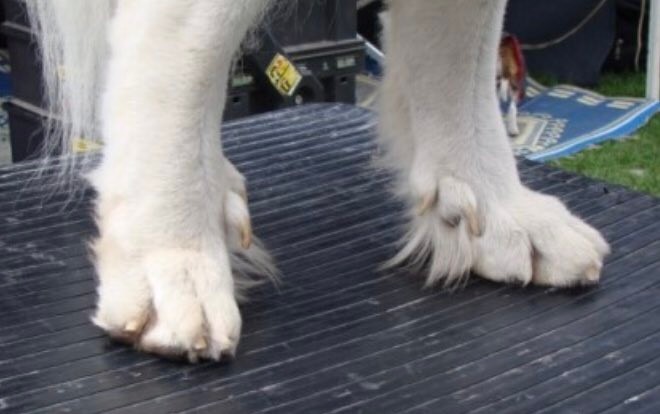
The Great Pyrenees breed is distinguished by a unique anatomical feature - double dew claws on their hind legs. Unlike regular dew claws found in most dog breeds, these specialized digits are attached by bone and muscle, serving crucial functions in mobility and stability. While some veterinarians advocate for their removal, these double dew claws are an essential breed characteristic that aids in climbing, running, and navigating rough terrain. Despite misconceptions about injury risks, properly maintained double dew claws rarely cause issues and should be preserved as a vital component of the Great Pyrenees' natural anatomy.
Great Pyrenees Double Dew Claws
Anatomical Structure and Purpose
The double dew claws on Great Pyrenees are unique anatomical features attached by bone and supported by muscle, unlike the loose dew claws found in other breeds. This bony attachment makes them strong and functional, serving as a "thumb-like" digit. The structure evolved as an ancient adaptation enabling these dogs to navigate steep mountainous terrain in their native Pyrenees region. When climbing hills or running at high speeds, these extra digits provide crucial stability and traction by digging into the ground.
Care Requirements and Professional Guidance
While some veterinarians may suggest removal, proper maintenance rather than surgical intervention is recommended. Regular nail trimming prevents overgrowth and potential pad injuries. Since these claws are positioned higher on the leg, careful inspection during grooming helps identify any developing issues early. When consulting veterinarians about double dew claw care, owners should seek professionals familiar with breed-specific traits, as some vets may incorrectly recommend removal based on general canine practices rather than Great Pyrenees' unique requirements. The breed standard specifically calls for double dew claws, and their removal is discouraged due to their functional importance and the surgical risks involved.
What Are Great Pyrenees Double Dew Claws?
Physical Characteristics and Location
Double dew claws are vestigial digits located on the hind legs of Great Pyrenees, consisting of two claws rather than one on each rear foot. They appear as a pad with two toenails positioned slightly higher on the foot compared to other toes. While single rear dew claws may indicate mixed breeding, properly formed double dew claws are a distinguishing breed characteristic required by the Great Pyrenees standard.
Breed Distinctiveness
While the previous sections covered structure and care, this section focuses on breed specificity. Great Pyrenees are not the only breed with double dew claws - Beaucerons, Briards, and Icelandic Sheepdogs also possess this trait. However, Great Pyrenees are perhaps the most well-known for this feature. Unlike some breeds where dew claws are floppy and prone to injury, the Great Pyrenees' double dew claws are firmly attached and highly functional. This makes them distinctly different from the loose single dew claws found in many other dog breeds that are commonly removed in puppyhood.
Why Double Dew Claws Should Not Be Removed
Medical and Ethical Considerations
While previous sections discussed the anatomical structure, this section focuses specifically on why removal is detrimental. Removing double dew claws is extremely painful due to their bone attachment and can be detrimental to the dog's mobility and function. The procedure is akin to amputating a human thumb, as it involves removing both bone and muscle tissue. This surgical intervention creates unnecessary risks and can impair the dog's natural ability to navigate terrain effectively.
Evidence Against Removal Claims
While some veterinarians advocate for removal citing injury risks, evidence shows that properly formed double dew claws rarely experience problems. The few reported issues typically involve dogs born with deformed dew claws. Contrary to common misconceptions suggesting they serve no purpose, these claws provide crucial stability during activities like running, climbing, and descending. Their removal can significantly impact a Great Pyrenees' natural movement patterns and athletic capabilities. The breed's history of successful mountain guardian work spanning centuries demonstrates the evolutionary importance and functionality of these appendages. When maintained properly through regular trimming and inspection, double dew claws pose minimal risk while providing substantial benefits to the dog's mobility and performance.
Veterinary Perspectives and Owner Advocacy
Professional Education and Misconceptions
While previous sections covered medical considerations, this section focuses on veterinary awareness. Many veterinarians incorrectly advise removal of double dew claws due to misconceptions about their purpose. This stems from generalized veterinary practices that don't account for breed-specific traits. Owners often face persistent pressure from veterinarians to remove these claws during routine procedures like spaying, requiring strong advocacy to preserve this vital breed characteristic.
Documentation and Breed Education
While earlier sections discussed physical characteristics, this section emphasizes documentation needs. Breed organizations and experienced owners emphasize the importance of educating veterinary professionals about Great Pyrenees double dew claws. Owners are advised to proactively discuss breed standards with their veterinarians and consider seeking second opinions from practitioners familiar with Great Pyrenees anatomy. Some owners report needing to switch veterinary clinics to protect their dogs from unwanted dew claw removal during other procedures. This highlights the need for improved professional education about breed-specific traits and the importance of respecting owner decisions regarding these functional anatomical features.
Conclusion
Great Pyrenees double dew claws are unique anatomical features that serve vital functional purposes, being firmly attached by bone and muscle unlike the loose dew claws found in other breeds. These specialized digits evolved to help these dogs navigate mountainous terrain and provide crucial stability during activities like running and climbing. Research clearly demonstrates that these are not vestigial structures, but rather important functional adaptations that should be preserved.
The evidence strongly indicates that double dew claw removal is both unnecessary and potentially harmful, despite some veterinary recommendations to the contrary. Proper maintenance through regular nail trimming and inspection is the appropriate approach, rather than surgical removal. This highlights the critical need for improved veterinary education about breed-specific traits and the importance of owner advocacy in preserving these functional anatomical features. Moving forward, increased awareness among veterinary professionals about the purpose and proper care of double dew claws will help ensure better health outcomes for Great Pyrenees dogs.